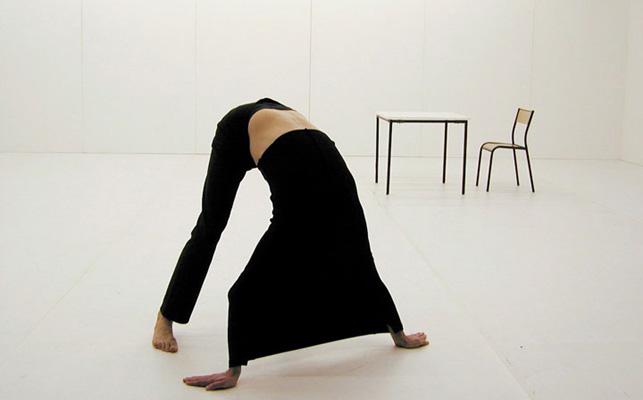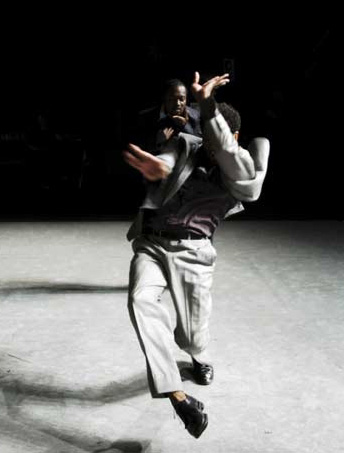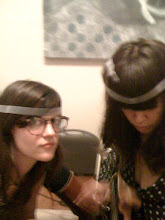
In her ongoing series
Whispering Pines, most often presented in the format of video, Shana Moulton adopts the guise of Cynthia, a feeble-spirited hypochondriac/agoraphobe that experiences vivid hallucinogenic fantasies within an absurdist (and---) setting created by the artist herself. This world combines a thrift-store/ gift-shop aesthetic with consumer culture, fad remedies, and new age kitsch. While the complex subjectivities regarding the obsolete objects and marginalized material culture may drive the narrative and simultaneously confine and liberate Cynthia, her environment as a whole resembles the opposite; a sort of Blue's Clues, Kid Pixian construction.
Effectively, this pitting of formal cinematic qualitities against pop detritus renders an innovative space for experimentation. Here, she brings together the "real" and the "virtual," calling each into question. Through the ascension of the Cynthia character via these various objects, as viewers, we gain access into Cynthia's psyche as well as her exterior reality.
For the performance at the New Museum on January 9, Moulton collaborated with composer-vocalist Nick Hallet to transform the work into a hybrid electronic-opera, with live sound controllers and instrument manipulation performed by Hallett, along with soprano opera singer Daisy Press and harpist Shelly Burgon. In the video works from this series, Cynthia is typically green screened into this fabled world, but in the live interactive media performance; Moulton incorporates multi-channel video installation (on three surfaces), real-time video, live animation, and green-screen compositing. Occasionally, Cynthia appears within the virtual videoscape, but most often, she inhabits the real video environment, acting in accordance with the pre-conceived image.
Hallett's pop- infused libretto and Daisy Press' vocals play a central role in the live performance, reflecting Moulton's visual aesthetic sonically. Since Cynthia never speaks, sound manipulations and songs represent her inner psychological processes, which suits the dream-like narrative, rendering a mediation that yolks at and reinforces the relationship between melodrama and pulp culture.
Some highlights
-I still can't get these songs out of my head. They were annoyingly catchy and almost too well placed.
-At the end of the performance, Cynthia puts on a peanut butter face-mask and covers herself in birdseed. This gesture is loaded with signification; conjuring childrens craft, obsolescense of our generation's youth culture, and most importantly a sort of social priming that allows us as humans to immerse ourselves within (and quite literally buy into) consumer culture. I think it also speaks to the recent marketing capitalization on neo-hippie idealism through the whole pseudo-green-living "movement" and how this fad has permeated America amid a culture of Snuggies and Sketcher's shape-ups.
“Whispering Pines 10 playfully demonstrates Cynthia’s loss of power to chic ideologies of self-empowerment, as Moulton’s character, mute, is subsumed by a digital video backdrop and kitschy pop librettos....The pained narcissism of incessant healing and grooming is masked as a heroic journey to wellness, for which seclusion is a necessary step.”
—Kareem Estefan, BOMB
“[Moulton's] relation with this character is somewhere between irony and pure love. You can never quite tell how much of it is mockery and how much of it is sincere appreciation for this aesthetic and style; and that's what makes the works so interesting, because Cynthia is a ridiculous person who is completely out of control of her environment...and we sort of sympathize with her and we laugh at her and we laugh along with her.”
—Michael Connor, Radiovisual
“The audience—complete with art stars and downtown celebs—loved the show and I can understand why. There’s a lot to enjoy from the piece and it is clever and amusing...the music was absolutely delightful.”
—Andy Horowitz, Culturebot
Shana Moulton was born in Oakhurst, CA and is a Brooklyn-based video, installation, and performance artist. Shana attended school at University of California at Berkeley and Carnegie Mellon University. She has participated in residencies at Skowhegan, De Ateliers, LMCC, and Harvestworks; she was also a New Commissions artist at Art in General in 2009. Moulton has exhibited and performed at venues such as The Wexner Center, Migros Museum, MoMA P.S.1, The Kitchen, Performa 09, Electronic Arts Intermix, the Andy Warhol Museum, and Socrates Sculpture Park. Her work has been reviewed in the Village Voice, Artforum, the Brooklyn Rail, the New York Times, Artnet Magazine, and Flash Art.
Nick Hallett is a NYC-based composer, vocalist, and cultural producer. His music has been performed at Joe’s Pub, ISSUE Project Room, The Kitchen, Le Poisson Rouge, and The Stone. Nick held the first RE:NEW RE:PLAY artist residency at the New Museum in May 2009, creating a four-part series of concerts connecting the voice to visual performance art, and he composed original music for the November 2009 Performa biennial in a concert at Town Hall. After organizing a performance for the Joshua Light Show at The Kitchen in 2007, Hallett became its music curator, collaborating with its founder, multimedia artist Joshua White to contextualize his pioneering approach to live cinema for contemporary audiences. With Zach Layton, he co-directs the celebrated Darmstadt new music series at ISSUE Project Room, which convenes a month-long Institute in the late spring and a festival of “Essential Repertoire” in the autumn. As a vocalist, he has performed the works of Anthony Braxton, Susie Ibarra, Meredith Monk, and Matthew Welch, among others. From 2000 to 2003, he led the band Plantains, a new wave-cabaret act incorporating electronic music and video, collaborating with Ray Sweeten and Seth Kirby, a recent retrospective of which was just released on I, Absentee.
Daisy Press was born into a performing family as the daughter of two musicians. Recently she was praised by the New York Times for her “winning subtlety and understatement” in her rendition of George Crumb’s new folk-based song cycle “Unto the Hills” at Miller Theater with the acclaimed group So Percussion, and then again for her “calm naturalness” for her performance of early and late Webern song cycles. Previously, she has sung in the works of Steve Reich, including “Music for 18 Musicians” and “Drumming,” which she has also performed as a guest artist at Juilliard. She was singer-in-residence at the Bang on a Can Marathon for two years. Press has performed Morton Feldman’s “Three Voices” (the studio recording of which is soon to be released on Cantaloupe records) and has served on the faculty at Manhattan School of Music, where she received her masters degree. Having been raised on a rock-and-roll tour (literally under the stage), she can occasionally be spotted performing at Irving Plaza with the preeminent Neil Diamond cover band, Super Diamond.















